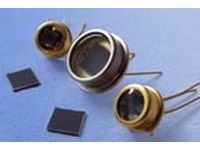Black Silicon CMOS Sensors 100 Times More Sensitive
The accidental discovery of black silicon several years ago is paving the way for new imaging sensors that are 100 times more sensitive to visible light than conventional silicon based detectors.
On Monday, Harvard University announced that it had exclusively licensed its portfolio of black silicon patents to SiOnyx, Inc. As part of the licensing agreement, Harvard had gained an equity position in SiOnyx and it will receive downstream royalties. SiOnyx was founded by Professor Eric Mazur and Dr. James Carey of Harvard University in 2006 and it has since raised $11 million in funding from investment partners. The company will focus on being a technology provider, working with industry partners to help incorporate its technology and providing entrepreneurs and experimenters with a new generation of supersensitive light detectors.
Black silicon was accidentally discovered in 1999 at Harvard University by Professor Eric Mazur and his team of graduate students, which included the then graduate student James Carey. During an Army-funded study of what new chemistry may occur when a laser is shone on metals, the team decided to also see what a femtosecond laser would do to silicon. They put a piece of silicon in a vacuum chamber, added halogen gas and then scanned the silicon with highly-intense laser pulses. After hundreds of pulses, the silicon turned black and its surface under an electron microscope showed a forest of tiny spikes that were of regular size and spacing. The team quickly realized some possible practical applications for the newly discovered black silicon, ranging from highly efficient solar panels to drug delivery systems.
Black silicon is a highly light-absorbent material that can absorb nearly all visible light, almost doubling the amount that regular silicon can absorb. It can also detect infrared light that regular silicon-based devices can not and it can be used as an efficient field emitter.
Although many creative applications for black silicon have been thought up, including the use in ray-like weapons, it would seem SiOnyx is primarily interested in the excellent photoconductive properties of black silicon. Apparently light sensors using black silicon are 100 times more sensitive to visible light than conventional silicon sensors, allowing a pixel 1-micrometer in size to produce the same signal as a traditional pixel 10-micrometer in size.
For consumers, smaller pixels could mean smaller sensors, which could use smaller lenses, resulting in cameras that are smaller and cheaper. Smaller pixels could also mean greater pixel densities, introducing a new generation of ultra-high resolution cameras that are capable of taking noise-free photos. Such technology may be closer than it seems, as SiOnyx had stated, “[it] is currently working with OEM partners within the imaging market to integrate Black Silicon as the next generation detector technology for CMOS imaging.”
Get Tom's Hardware's best news and in-depth reviews, straight to your inbox.
-
ckthecerealkiller Good read. I'm glad I put off buying a really good camera for now. Sounds like in a few years things are going to take a good step forward.Reply -
Pixels303 I certainly hope this one doesn't get bought up and shelved like the Holographic removable Data discs. We could have had 400Gigs in our machine like a floppy disc with read and write speeds faster than hard disks. I guess it threatened the current technologies.Reply
So, in this case, I hope it isn't too good, or we may never see it in our lifetime. -
kschoche I think it will be cool to be able to have respectable quality sensors built into future cell phones, even a 5 or 7mp on a phone would be awesome, no more of this 1.1mpx crap please :DReply
-
ceteras I'd like to see black silicon sensors that are the same size and resolution as the usual ones, resulting in a better capturing of dark images.Reply

